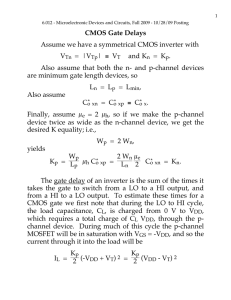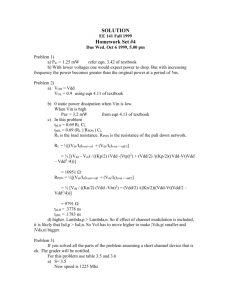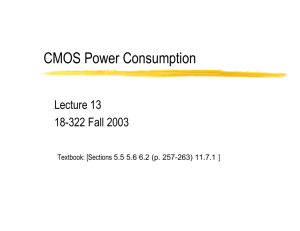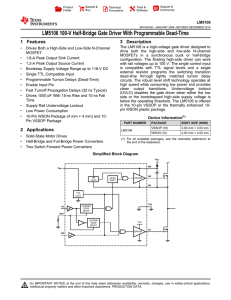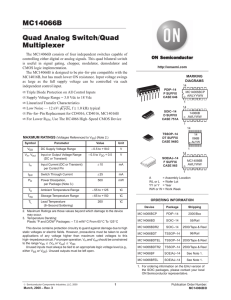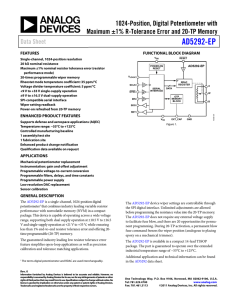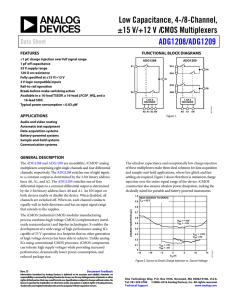ECE 124a/256c Advanced VLSI Design
advertisement
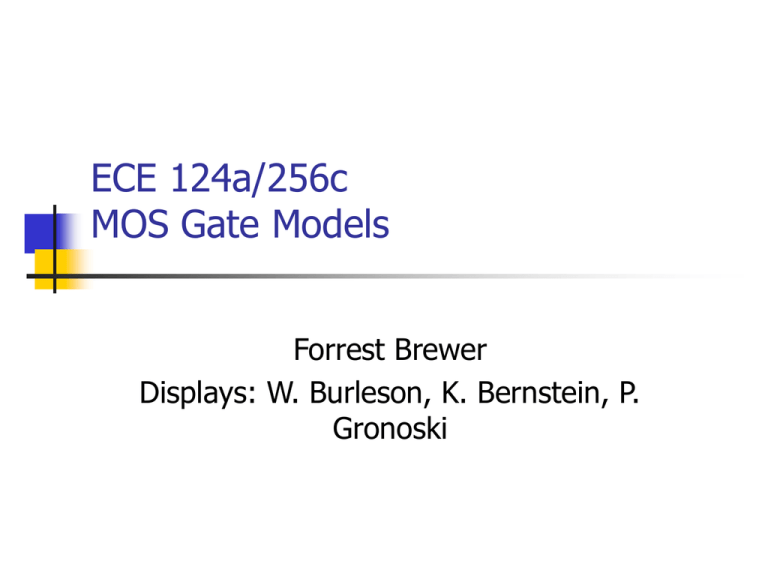
ECE 124a/256c MOS Gate Models Forrest Brewer Displays: W. Burleson, K. Bernstein, P. Gronoski Basics (MOS Electrical Model) kW VF2 I ds ((Vgs VT )VF )(1 Vds ) L 2 Nonlinear model with 3 conduction modes: Linear Mode (Vds < Vgs-VT) and (Vds < Vsat): VF = Vds Saturation (Vds > Vgs-VT) and (Vds < Vsat): VF = Vgs-VT Velocity Saturation (Vds > Vsat): VF = Vsat VF = Min(Vgs-VT, Vsat, Vds ) Body Effect Threshold is function of back potential 0.18m Increases difficulty of turn on for junction reverse bias increase Ff N-type 0.4 (V) 0.32 P-type 0.4 (V) -0.42 VT VT 0 2 f VSB 2 f kT N a f ln q ni 2q Si N a Cox Velocity Saturation Carrier Velocity Saturates at about 1.7x107cm/s For short channel (small L) this occurs at Vsat Mobility (m) is a function of doping and temperature 0.18m m Vsat N-type 400 0.8V (cm2/Vs) P-type 150 2.2V (cm2/Vs) Vsat (1.7 107 cm / s) L(cm) m(cm2 / Vs) m(T ) m(300 K )(T / 300) 3 / 2 MOS Capacitors Gate (assume constant) = Si WL/tox Source/Drain Bottom (Area) CJ mJ SideWall (Perimeter) CJSW mJSW Equivalent Capacitance (Swing Vlow to Vhigh) Transient Capacitor Parasitics Only capacitors which change potential over the swing are included. Cgs and Cgd are often modeled as Cg and Cgso, Cgdo. Cgdo models the feed though (input to output) capacitance For low swing rates, double Cgdo For high swing rates, start the output swing from the offset output voltage Cgdo and Cload produce a capacitive voltage divider. G CGS C GD S D CSB CGB CDB B Static Complementary CMOS VDD In1 In2 PUN InN In1 In2 InN PMOS only F(In1,In2,…InN) PDN NMOS only PUN and PDN are logically dual logic networks Inverter Threshold vs. N/P Ratio 1.8 1.7 1.6 1.5 M V (V) 1.4 1.3 1.2 1.1 1 0.9 0.8 10 0 10 W /W p n 1 Inverter Gain 0 -2 -4 gain gain -6 -8 -10 -12 -14 -16 -18 0 0.5 1 1.5 2 2.5 1 k nVDSAT ( n ) k pVDSAT ( p ) I D (VM ) n p 1 r (VM V TnVDSAT ( n ) / 2)( n p ) CMOS Inverter Propagation Delay V DD tpHL = CL Vswing/2 Iav V out Iav CL I AV V in = VDD I ds (init ) I ds ( final ) 2 Approximating Iavg Prescription from Hodges and Jackson Assume input rise is instantaneous: ignore rise-time effects Average charging current at endpoints of swing Initial point is usually a supply rail, final point is threshold of next gate Iinitial (@ Vout = Vinit) Ich Actual Current Ifinal (@Vout = Vfinal) Vout Hodges-Jackson Current Averaging FET’s act as a current source Simple model for full-swing current: I1 is initial current at start of swing I2 is current at threshold of next stage Iavg is approximated by (I1+I2)/2 Delay t CV CReff 0.69CReq I avg Transient Response 3 2.5 (V) 1 tpHL tpLH out 1.5 V 2 0.5 0 -0.5 0 0.5 1 1.5 t (sec) 2 2.5 x 10 -10 Constructing a Complex Gate Logic Dual need not be Series/Parallel Dual In general, many logical dual exist, need to choose one with best characteristics Use Karnaugh-Map to find good duals Goal: find 0-cover and 1-cover with best parasitic or layout properties Maximize connections to power/ground Place critical transistors closest to output node Know the order of arrival of signals! – order the transitions if possible Example: Carry Gate C C’ AB AB’ 0 0 0 1 A’B’ 1 1 A’B 0 1 F = (ab+bc+ac)’ Carry ‘c’ is critical Factor c out: (Why c?) F=(ab+c(a+b))’ 0-cover is n-pull up 1-cover is p-pull down Example: Carry Gate (2) f' a c b a b Pull Down is easy Order by maximizing connections to ground and critical transistors For pull up – Might guess series parallel graph dual– but would guess wrong Example: Carry Gate (3) a b c a b f' Series/Parallel Dual 3-series transistors 2 connections to Vdd 7 floating capacitors Example: Carry Gate (4) a a b b Pull Up from 1 cover of Kmap c f' Get a’b’+a’c’+b’c’ Factor c’ out 3 connections to Vdd 2 series transistors Co-Euler path layout Moral: Use Kmap! Euler Path For CMOS standard cell, and Euler path often helps to organize the transsistor order so that a faster, more dense cell can be constructed. Ideally, the p-fet and n-fet sub-circuits can be traversed in identical transistor orders to create a layout without diffusion (thinox) gaps. Euler Path: Traversal of entire schematic (every transistor) without traversing any transistor twice. Possible only if 0 or 2 odd nodes in schematics. Node count is the number of transistors incident on a common point. If 0, any point can be start (will also be end) of path, for 2, one of the odd nodes is the start and the other is the end. Euler Path II Eg. Carry Gate Path: b-a-c-b-a or a-bc-a-b or … Can sometimes also minimize the routing by careful choice of order b c a a a b c b f' b c a a b a X X X X X X X X X X b Static Logic: Rules of Thumb 1. Step-up (alpha) ratio of 4 produces minimum power-delay product 2. P vs. N (beta) ratio of 2 balances pullup and pull-down times and noise margins. 3. Approximately 75% of static logic are NAND stacks (limit stack to 3-4, use ordering and tapering for speed) More Rules of Thumb 1. Glitches consume approximately 15% of overall chip power. 2. Crossover (short-circuit) current consumes ~ 10% of a static chip’s total power (but is a function of input/output slews, ie sizing) Ratio Logic VDD Resistive Load VDD Depletion Load RL PDN VSS (a) resistive load PMOS Load VSS VT < 0 F In1 In2 In3 VDD F In1 In2 In3 PDN VSS (b) depletion load NMOS F In1 In2 In3 PDN VSS (c) pseudo-NMOS Goal: to reduce the number of devices over complementary CMOS as a means to reduce parasitics (usually for performance). Pseudo NMOS VDD A B C D F CL VOH = VDD (similar to complementary CMOS) V2 k 2 OL p V k V – V V – ------------- = -----– V n DD Tn OL DD Tp 2 2 kp V OL = VDD – V T 1 – 1 – -----(assuming that V T = V Tn = VTp ) kn SMALLER AREA & LOAD BUT STATIC POWER DISSIPATION!!! Even Better Noise Immunity/Density VDD M1 VDD M2 Out A A B B Out PDN1 PDN2 VSS VSS Differential Cascode Voltage Switch Logic (DCVSL) DCVSL Example Out Out B B A B B A XOR-NXOR gate DCVSL Transient Response V olta ge [V] 2.5 AB 1.5 0.5 -0.5 0 AB A,B 0.2 A,B 0.4 0.6 Time [ns] 0.8 1.0 Complementary Pass Gate Logic (CPL) Pass-gate Logic issues Limited fan-in Excessive fan-out Noise vulnerability (not restoring) Supply voltage offset/bias vulnerability Decode exclusivity (else short-circuit!) Poor high voltage levels if NMOS-only Body effect Pass-Gate Logic Rules of Thumb Pass-logic may consume half the power of static logic. But be careful of Vt drop resulting in static leakage. Pass-gate logic is not appropriate when long interconnects separate logic stages or when circuits have high fan-out load (use buffering). Dynamic Logic Idea – use the low leakage of FETs to store charge instead of moving current. Provides higher density, faster operation at the cost of reduced noise immunity and tricky design… Domino is by far the most common style in CMOS Domino logic (single and dual-rail) Dynamic Logic Rules of Thumb Dynamic logic is best for wide OR/NOR structure (e.g. bit-lines), providing 50% delay improvement over static CMOS. Dynamic logic consumes 2x power due to its phase activity (unconditional pre-charging), not counting clock power. Domino Rules of Thumb Typical domino keepers have W/L = 5-20% of effective width of evaluate tree. Typical domino output buffers have a beta ratio of ~ 6:1 to push the switch point higher for fast rise-time but reduced noise margin. Conventional and Delay-precharge domino Advanced Domino Logic forms Concerns in Dynamic Logic Charge-sharing Charge-leakage Interconnect coupling Back-gate coupling Supply noise and variation Back-gate coupling Manchester Carry Chain VDD Ci,0 P0 P1 P2 P3 P4 G0 G1 G2 G3 G4 Sizing the Manchester Carry Chain Discharge Transistor 1 R1 MC C1 R2 2 M0 C2 3 R3 M1 R4 4 M2 C3 C4 5 R5 M3 C5 6 R6 M4 Out C6 25 400 20 300 Area Speed N N t 0.69 Ri C j , R Req k , C C p kCn i 1 j i 15 100 10 5 1 200 1.5 2.0 2.5 3.0 k Speed (normalized by 0.69 RC) 0 1 1.5 2.0 2.5 3.0 k Area (in minimum size devices) Domino Nor16 (zero-detect) Flip-flops/latches/state elements Flip-flops occupy a special place in conventional digital design Always Dynamic Behavior Allow time coherence across large parts of the circuit Preserve data across synchronization boundaries --Inherently asynchrnous design Level-sensitive latch pair Modified Svensson Latch of 21064 Tri-state based static latch Master-slave (Dynamic) FF Sense Amplifier-Based Flip-Flop Courtesy of IEEE Press, New York. 2000 Sense Amplifier-Based Flip-Flop The first stage is unchanged sense amplifier Second stage is sized to provide maximum switching speed Driver transistors are large Keeper transistors are small and disengaged during transitions On-chip Memory Typically largest fraction of chip area Nearly always topologically organized (low Rent parameter <0.6) Simple wire/area planning rules Generic memory block diagram SRAM read operation SRAM cell sized to avoid read-disturbance Realistic layout issues in SRAM cell Asymmetric Read/Write Ports Multi-porting Split Row Decoder Column mux and sense-amp 21264 Integer Unit floorplan 21264 Integer Register File cells 21264 L1 Dcache 21164 L2 Cache
